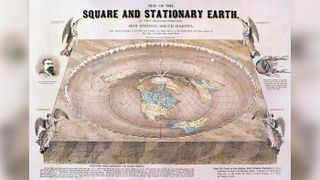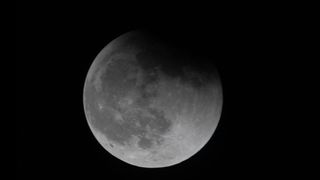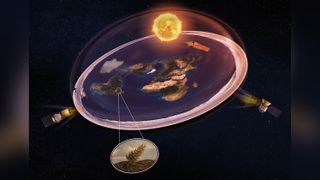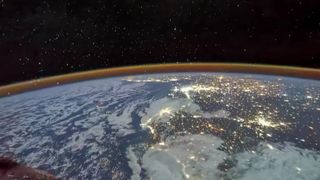Flat Earth 'theory': Why do some people think the Earth is flat?
Flat-earthers believe one of the most curious conspiracy theories on the internet. Here's a look at what they believe and why.

Of all the conspiracy theories that litter the Internet, the flat Earth conspiracy is quite possibly the most curious. After all, the ancient Greeks figured out the planet's shape (and even its circumference) in the third century B.C.
But a fringe society founded in the 1950s, dedicated to insisting that the Earth is flat, has given rise to a modern ground of flat Earth adherents. These believers claim that the Earth is a flat disc, and that evidence that it is round — say, pictures taken from space — are an elaborate hoax involving multiple governments. Opinions differ on exactly how the flat Earth works, with believers concocting elaborate versions of physics and creative interpretations of the solar system to make their theories work.
No one knows how many flat Earth believers are out there. According to Smithsonian Magazine, membership in the Flat Earth Society, founded in 1956, once reached 3,500 people. Today, the society claims more than 500 members on its roster. But some believers want nothing to do with the Flat Earth Society, according to a 2019 CNN article, with some attendees of the Flat Earth International Conference in Dallas that year telling the news agency that the organization is a government-sponsored front designed to make Flat Earthers look bad. (The Flat Earth Society responded to this by telling CNN, "We are not a government-controlled body. We're an organization of Flat Earth theorists that long predates most of the FEIC newcomers to the scene.")
Who are flat-earthers?
As the Flat Earth Society/Flat Earth International Conference schism reveals, flat-earthers are not a monolithic group. The current president of the Flat Earth Society, Daniel Shenton, is a Londoner who now lives in Hong Kong. Robbie Davidson, who organizes the annual Flat Earth International Conferences, is a Canadian who espouses Biblical literalism and opposes what he calls "scientism."
A 2017 national poll by Public Policy Polling found that only 1% of Americans believed the Earth was flat, with an additional 6% saying they weren't sure. There was very little evidence of differences in this belief by political affiliation, with any differences between Trump voters, Clinton voters and third-party voters falling within the poll's margin of error of 3.2%.
A 2018 article in the Colorado Sun on a flat Earth convention in Denver found that many attendees believed a whole suite of conspiracy theories, such as that all politicians are actors and that powerful shadowy forces control the world.
Flat-earthers occasionally get a boost from celebrity believers. For instance, on Jan. 25, 2016, rapper-singer Bobby Ray Simmons Jr. (known as B.o.B) released a track called "Flatline" in which he disses astrophysicist Neil deGrasse Tyson, after the two had a Twitter battle over the spherical-ness of the planet. B.o.B is convinced Earth is flat. A day earlier, the rapper tweeted: "No matter how high in elevation you are... the horizon is always eye level ... sorry cadets... I didn't wanna believe it either." In 2018, NBA player Kyrie Irving had to apologize after causing a media controversy by speculating that the Earth was flat on a 2017 podcast.
Flat Earth map

The leading flat-earther theory holds that Earth is a disc with the Arctic Circle in the center and Antarctica, a 150-foot-tall (45 meters) wall of ice, around the rim. NASA employees, they say, guard this ice wall to prevent people from climbing over and falling off the disc. (In keeping with their skepticism of NASA, known flat-earther conspiracy theorist Nathan Thompson approached a man he said was a NASA employee in a Starbucks in mid-May 2017. In a YouTube video of the exchange, Thompson, founder of the Official Flat Earth and Globe Discussion page, shouted that he had proof the Earth is flat — apparently saying an astronaut drowning was that proof — and that NASA is "lying.")
Furthermore, Earth's gravity is an illusion, they say. Objects do not accelerate downward; instead, the disc of Earth accelerates upward at 32 feet per second squared (9.8 meters per second squared), driven up by a mysterious force called dark energy. Currently, there is disagreement among flat-earthers about whether or not Einstein's theory of relativity permits Earth to accelerate upward indefinitely without the planet eventually surpassing the speed of light. (Einstein's laws apparently still hold in this alternate version of reality.)
As for what lies underneath the disc of Earth, this is unknown, but most flat-earthers believe it is composed of "rocks."
It's worth noting that all of the above is completely contentious even within the flat Earth community. "None of us believe that we're a flying pancake in space," Davidson told CNN in the 2019 article. At the Flat Earth International Conferences, it's more common to believe that space simply does not exist at all and the disc of the Earth sits still, he said. One speaker at the 2018 FEIC even argued that Earth is neither a sphere nor a disc, but instead is shaped like a diamond, according to The Guardian.
Do flat-earthers think the moon is flat?

Flat Earth opinions about the moon vary. Some think that while Earth is flat, the moon and sun are spheres, Live Science's sister site Space.com reported. In this vision of the solar system, Earth's day and night cycle is explained by positing that the sun and moon are spheres measuring 32 miles (51 kilometers) that move in circles 3,000 miles (4,828 km) above the plane of the Earth. (Stars, they say, move in a plane 3,100 miles up.) Like spotlights, these celestial spheres illuminate different portions of the planet over a 24-hour cycle. Flat-earthers believe there must also be an invisible "antimoon" that obscures the moon during lunar eclipses.
On YouTube, there are videos pointing to shadows in pictures of the moon and arguing that the moon is transparent, and thus just a light. One speaker at the 2018 conference attended by a Guardian reporter made a case for the moon as a projection.
What is the Zetetic Method?
If flat-earthers seem hard to dissuade based on standard scientific evidence, there's a reason for that: flat Earth theorizing follows from a mode of thought called the "Zetetic Method." The Zetetic Method is an alternative to the scientific method, developed by a 19th-century flat-earther, in which sensory observations reign supreme.
"Broadly, the method places a lot of emphasis on reconciling empiricism and rationalism, and making logical deductions based on empirical data," Flat Earth Society vice president Michael Wilmore, an Irishman, told Live Science in 2017.

In Zetetic astronomy, the perception that Earth is flat leads to the deduction that it must actually be flat; the antimoon, NASA conspiracy and all the rest are just rationalizations for how that might work in practice.
Those details make the flat-earthers' theory so elaborately absurd it sounds like a joke, but many of its supporters genuinely consider it a more plausible model of astronomy than the one found in textbooks. In short, they aren't kidding.
"The question of belief and sincerity is one that comes up a lot," Wilmore said. "If I had to guess, I would probably say that at least some of our members see the Flat Earth Society and Flat Earth Theory as a kind of epistemological exercise, whether as a critique of the scientific method or as a kind of 'solipsism for beginners.' There are also probably some who thought the certificate would be kind of funny to have on their wall. That being said, I know many members personally, and I am fully convinced of their belief."
Wilmore counts himself among the true believers. "My own convictions are a result of philosophical introspection and a considerable body of data that I have personally observed, and which I am still compiling," he said.
Wilmore and the society's president Shenton both think the evidence for global warming is strong, despite much of this evidence coming from satellite data gathered by NASA, the kingpin of the "round Earth conspiracy." They also accept evolution and most other mainstream tenets of science. This is in contrast to Davidson, who disputes other scientific theories and findings, such as evolution, that contradict a strict interpretation of the Bible.
How we know the Earth is NOT flat?

Despite the claims from flat-earthers, there are plenty of ways to know that the world is round. One quick option is to check out NASA's image library, which is chock-full of nice, curvy pictures of the globe taken from the International Space Station. If NASA is hoaxing everyone, they're committed to the bit.
Don't trust NASA? The Russians also snap pictures of the round Earth, Space.com reported. So does Japan's space agency. And China's.
For the flat-earther convinced that all these countries put aside their political tensions in order to maintain the fiction that Earth is spherical, there are also ways to check on the planet's shape with one's own eyes. One of the simplest is to go to a harbor and watch the ships depart. As a ship disappears over the horizon, the bottom of the ship will go first, followed gradually by the mast.
Related: 8 ways life would get weird on a flat Earth
You can also take a page out of the ancient Greeks' book. Ancient Hellenistic philosophers figured out that the world had to be a globe based on a few observations. One was that the stars aren't the same in the Northern and Southern Hemispheres: From opposite halves of the Earth, you're clearly looking out at different quadrants of space. Another was that Earth's shadow on the moon's surface during lunar eclipses is curved.

The Greeks even figured out how to calculate an approximate circumference of the Earth with no fancier tools than a stick and the light of the sun. By measuring the angle of a shadow cast by the sun at the same time and day in two cities a known distance apart, the philosopher Eratosthenes was able to calculate that the planet's circumference was between 24,000 and about 29,000 miles (38,600 and 46,670 kilometers). (It's actually 24,900 miles.) The very fact that the angle of the sun differs on different parts of the planet indicates that we're all sitting on a globe.
Conspiracy theory psychology

As inconceivable as their belief system seems, it doesn't really surprise experts. Karen Douglas, a psychologist at the University of Kent in the United Kingdom who studies the psychology of conspiracy theories, says flat-earthers' beliefs cohere with those of other conspiracy theorists she has studied.
"It seems to me that these people do generally believe that the Earth is flat. I'm not seeing anything that sounds as if they're just putting that idea out there for any other reason," Douglas told Live Science.

Karen Douglas is professor of social psychology at the University of Kent in the U.K., specializing in the psychology of conspiracy theories. Karen’s research regularly features in the media, and she gives public talks. She is a founding member of an international network of conspiracy theory scholars.
She said all conspiracy theories share a basic thrust: They present an alternative theory about an important issue or event, and construct an (often) vague explanation for why someone is covering up that "true" version of events. "One of the major points of appeal is that they explain a big event but often without going into details," she said. "A lot of the power lies in the fact that they are vague."
The self-assured way in which conspiracy theorists stick to their story imbues that story with special appeal. After all, flat-earthers are more adamant that the Earth is flat than most people are that the Earth is round (probably because the rest of us feel we have nothing to prove). "If you're faced with a minority viewpoint that is put forth in an intelligent, seemingly well-informed way, and when the proponents don't deviate from these strong opinions they have, they can be very influential. We call that minority influence," Douglas said.
In a study published online March 5, 2014, in the American Journal of Political Science, Eric Oliver and Tom Wood, political scientists at the University of Chicago, found that about half of Americans endorse at least one conspiracy theory, from the notion that 9/11 was an inside job to the JFK conspiracy. "Many people are willing to believe many ideas that are directly in contradiction to a dominant cultural narrative," Oliver told Live Science. He says conspiratorial belief stems from a human tendency to perceive unseen forces at work, known as magical thinking.
Eric Oliver is a professor of Political Science at the University of Chicago. His research focuses on American politics, public opinion, political psychology, local politics, racial attitudes and self knowledge. He has published a number of books, the most recent of which was Enchanted America: How Intuition and Reason Divide Our Politics (The University of Chicago Press, 2018). He has also authored numerous articles in journals.
However, flat-earthers don't fit entirely snugly in this general picture. Most conspiracy theorists adopt many fringe theories, even ones that contradict each other. Meanwhile, flat-earthers' only hang-up is the shape of the Earth. "If they were like other conspiracy theorists, they should be exhibiting a tendency toward a lot of magical thinking, such as believing in UFOs, ESP, ghosts the Devil, or other unseen, intentional forces," Oliver wrote in an email. "It doesn't sound like they do, which makes them very anomalous relative to most Americans who believe in conspiracy theories."
Editor's Note: This article was first published on Oct. 26, 2012, and updated by Stephanie Pappas on Dec. 16, 2021 and Oct. 17, 2022.
Sign up for the Live Science daily newsletter now
Get the world’s most fascinating discoveries delivered straight to your inbox.

Stephanie Pappas is a contributing writer for Live Science, covering topics ranging from geoscience to archaeology to the human brain and behavior. She was previously a senior writer for Live Science but is now a freelancer based in Denver, Colorado, and regularly contributes to Scientific American and The Monitor, the monthly magazine of the American Psychological Association. Stephanie received a bachelor's degree in psychology from the University of South Carolina and a graduate certificate in science communication from the University of California, Santa Cruz.
